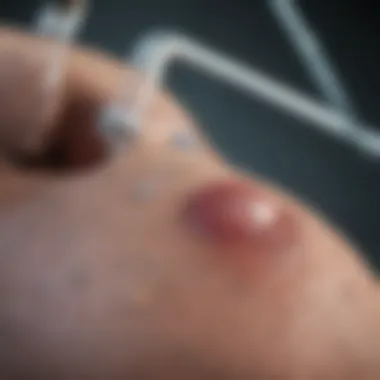Comprehensive Analysis of PCP Pneumonia Treatment


Intro
Pneumocystis pneumonia (PCP) represents a significant challenge within the realm of infectious diseases, especially among those with compromised immune systems. Understanding how to treat PCP effectively is essential for improving patient outcomes and addressing the implications this infection has on overall health. This article seeks to provide an exhaustive exploration of the methodologies and treatment options available, while also addressing the complex interactions that underpin this condition.
In recent years, there has been an increasing recognition of the factors that contribute to the risk of developing PCP. These factors can range from underlying conditions, such as HIV/AIDS, to certain medications that can dampen the immune response. The treatment landscape is evolving. It is important to understand both the traditional approaches, as well as the latest advancements in pharmacotherapy.
Next, we will explore the research context in which PCP treatment strategies are formulated.
Understanding PCP Pneumonia
Understanding Pneumocystis pneumonia (PCP) is fundamentally crucial in the context of this article. As an opportunistic infection, PCP predominantly impacts individuals with weakened immune systems. Therefore, comprehension of its underlying mechanisms and implications can lead to more effective treatment and management for affected patients.
In this section, we will address key elements that delineate the nature of PCP, giving readers insight into its definition and overall significance in the broader context of infectious diseases. The discussion will also encompass the biological aspects of the causative agent and the epidemiological trends that render specific populations more vulnerable to infection.
Definition and Overview
Pneumocystis pneumonia is an infection caused by Pneumocystis jirovecii, a fungus that leads to severe pneumonia, particularly in immunocompromised individuals. It typically presents with respiratory symptoms and can be fatal if left untreated.
This condition was first recognized in the 1900s. Initially, it was thought to be a protozoan but was later reclassified as a fungus. The understanding of its clinical manifestations has evolved, especially in the context of HIV/AIDS, where its prevalence spiked.
To characterize PCP effectively, it's important to note that the infection generally occurs when the CD4 cell count in the body is below 200 cells/mm³.
Pathophysiology of Pneumocystis Pneumonia
The pathophysiology of PCP revolves around the interaction of Pneumocystis jirovecii with the host's immune system. When a person is immunocompromised, the ability to mount an effective immune response against the pathogen diminishes. The fungus invades the alveoli, leading to the accumulation of inflammatory cells and exudates, which causes impaired gas exchange and results in hypoxia.
The alteration of the surfactant production further complicates the respiratory function. Inflammation can worsen, leading to lung damage and increased susceptibility to secondary infections.
Epidemiology and Risk Factors
PCP predominantly affects individuals with compromised immune systems. The most significant risk factors include:
- HIV/AIDS
- Organ transplants
- Cancer patients receiving chemotherapy
- Patients on immunosuppressive therapies, such as corticosteroids
- Genetic immune deficiencies
Statistically, HIV/AIDS patients are among the most affected, where PCP is one of the leading causes of morbidity and mortality in this group. It is critical to understand that early detection and preventive measures, especially in high-risk populations, can significantly reduce rates of PCP.
In summary, comprehensively understanding PCP pneumonia involves an intricate interplay between the pathogen and the host immune system, as well as recognition of the risk factors leading to the disease. This framework lays the essential foundation for exploring diagnosis and treatment methodologies, which are crucial for healthcare professionals managing this condition.
Diagnosis of PCP
The diagnosis of Pneumocystis pneumonia (PCP) is crucial for effective treatment and management of the disease. An accurate diagnosis allows healthcare providers to differentiate PCP from other lung infections, which is essential given the unique treatment protocols associated with this condition. Given the potential severity of PCP in immunocompromised patients, prompt identification can significantly improve patient outcomes. It also aids in initiating appropriate therapeutic interventions in a timely manner, reducing the risk of complications related to delayed treatment.
Clinical Presentation
The clinical presentation of PCP often includes a gradual onset of symptoms, which can lead to challenges in early detection. Patients typically report coughing, shortness of breath, and fever. These symptoms may escalate over time and could result in respiratory distress if not addressed quickly.
Other nonspecific symptoms such as fatigue and weight loss are also common. In some cases, hypoxia may become evident, necessitating immediate intervention. Because PCP can mimic other respiratory diseases, a thorough clinical history and physical examination are essential.


Identifying the nature of these presenting symptoms in an immunocompromised patient can provide direct clues to possible PCP. Detailed attention to the onset and progression of signs will help in formulating an effective differential diagnosis.
Diagnostic Imaging Techniques
Diagnostic imaging techniques are fundamental in the diagnosis of PCP. High-resolution computed tomography (HRCT) scans of the chest can show specific patterns indicative of PCP. The presence of ground-glass opacities, which appear as diffuse haziness in the lungs, is a hallmark sign of this infection.
Chest X-rays may also be utilized as an initial assessment tool, though they are often less sensitive than HRCT. X-rays typically reveal bilateral infiltrates that may be subtle or obscured, making them less reliable compared to more advanced imaging modalities.
Regular imaging not only assists in identifying the presence of PCP but also helps in monitoring disease progression and response to treatment. This is particularly crucial for patients undergoing therapy, as timely adjustments to treatment can further mitigate risks associated with the disease.
Laboratory Testing and the Role of Sputum Analysis
Laboratory testing plays a pivotal role in confirming the diagnosis of PCP, and sputum analysis is one of the most common methods utilized. A sample of the patient's sputum can be analyzed for the presence of Pneumocystis jirovecii, the fungal pathogen responsible for PCP.
Microscopic examination of induced sputum may reveal characteristic cysts, which are diagnostic of the infection. However, positive identification can sometimes be challenging due to the lower yield of cysts in some cases. As a result, alternative methods such as bronchoalveolar lavage are often necessary. This invasive procedure allows for a more comprehensive examination and often yields better results when initial sputum samples are inconclusive.
In addition to these methods, polymerase chain reaction (PCR) testing is gaining importance due to its high sensitivity and specificity. PCR testing can detect the genetic material of Pneumocystis jirovecii, allowing for earlier and more accurate diagnoses, which is particularly beneficial in severely immunocompromised individuals where rapid intervention is crucial.
"Timely and accurate diagnosis of PCP paves the way for effective treatment strategies, ultimately improving patient outcomes."
In summary, the diagnosis of PCP is multifaceted, involving a comprehensive approach that includes clinical assessment, timely imaging, and targeted laboratory analysis. Understanding these components not only aids in confirming the diagnosis but also informs treatment pathways and overall management strategies.
Current Treatment Guidelines
The current treatment guidelines for Pneumocystis pneumonia (PCP) are essential to ensure that clinicians effectively address this serious opportunistic infection. These guidelines provide a structured approach to facilitate timely and appropriate therapeutic interventions, particularly in immunocompromised patients who are at greater risk. Adhering to evidence-based recommendations can significantly improve patient outcomes and reduce morbidity associated with PCP.
First-line Pharmacological Therapies
The foundation of treating PCP lies in the use of first-line pharmacological therapies. The mainstay of treatment is trimethoprim-sulfamethoxazole (TMP-SMX), a combination antibiotic that exhibits potent antifungal properties against Pneumocystis jirovecii. This therapy is recommended for individuals with moderate to severe PCP, as it effectively alleviates symptoms and addresses the underlying infection.
Recent studies underscore the importance of timely initiation of TMP-SMX therapy. Delays in treatment can lead to adverse outcomes, particularly respiratory distress. Ensuring patients receive the correct dosage, typically a double-strength tablet three times daily, can enhance the effectiveness of the treatment. Furthermore, when TMP-SMX is contraindicated, alternatives such as pentamidine or atovaquone are available, though they may not be as effective as the preferred option.
Alternative Treatment Options
In specific scenarios where first-line treatments are not suitable, healthcare providers can consider alternative treatment options. Pentamidine is an aerosolized agent that can be useful for patients who cannot tolerate TMP-SMX. This therapy, administered via a nebulizer, can minimize systemic side effects while still delivering effective treatment.
Atovaquone, an oral medication, also serves as an alternative for patients with mild to moderate disease or those with sulfamethoxazole allergy. It is important to recognize that while these alternatives provide crucial backup options, they do not replicate the efficacy of TMP-SMX in severe cases.
Dosage and Administration Considerations
Practitioners must pay careful attention to dosage and administration guidelines to optimize treatment outcomes. The recommended dose for TMP-SMX is critical and should be adjusted based on the patient's renal function. For patients with renal impairment, adjusting the dose is necessary to avoid potential toxicity.
In cases where patients exhibit significant side effects, transitioning to alternative medications may become necessary, but close monitoring is essential in these instances. Continuing to assess the patient's response to treatment allows healthcare providers to adjust therapeutic plans efficiently.
Overall, a nuanced understanding of dosage, timing, and patient-specific factors is central to achieving successful treatment outcomes in PCP management.
"Timely administration of appropriate pharmacological therapies is critical in reducing the risk of adverse outcomes in patients with Pneumocystis pneumonia."


In summary, the treatment guidelines for PCP serve as a vital resource in the management of this serious infection. By adhering to established protocols and considering patient-specific variables, healthcare providers can enhance the care delivered to those affected by this condition.
Adjunctive Treatment Strategies
In managing Pneumocystis pneumonia (PCP), adjunctive treatment strategies are critical to support pharmacological interventions and improve patient outcomes. These strategies address various aspects of care, particularly in patients who are at higher risk due to underlying immunocompromised states. Utilization of adjunctive therapies contributes to enhancing the overall treatment efficacy and minimizing complications.
Corticosteroids in PCP Management
Corticosteroids play a significant role in the management of PCP, especially for patients with severe forms of the illness. The literature suggests that corticosteroids can reduce inflammation in the lungs, which is beneficial considering the immune response triggered by Pneumocystis jirovecii. Studies indicate that early initiation of corticosteroid therapy can lead to improved survival rates and clinical outcomes. The standard recommendation involves administering corticosteroids such as prednisone alongside standard antibiotics.
This approach might help mitigate the risks associated with the inflammatory response that often accompanies infections in immunocompromised individuals. It is necessary, however, to weigh the benefits against potential side effects of corticosteroid therapy, which can include hyperglycemia or increased susceptibility to further infections. Healthcare providers must carefully assess patient conditions to tailor dosages and administration routes appropriately.
Use of Oxygen Therapy
Oxygen therapy is another important adjunctive treatment strategy in PCP management. Due to the potential for impaired gas exchange caused by pneumonia, many patients present with hypoxia. Administering supplemental oxygen can help address this immediate concern, enhancing oxygenation and reducing the work of breathing. This is particularly critical in cases where patients have low arterial oxygen saturation levels (SpO2).
The implementation of oxygen therapy should be individualized based on the severity of hypoxia. Continuous monitoring is recommended to adjust oxygen delivery effectively. High-flow nasal cannulas or non-invasive ventilation options can be considered for those requiring more significant respiratory support. Continuous assessment of the patient's response to therapy is vital.
"Oxygen therapy can significantly increase quality of life in patients suffering from severe PCP."
Challenges in Treatment
The treatment of Pneumocystis pneumonia (PCP) poses several significant challenges that demand attention from healthcare professionals. These challenges not only affect patient outcomes but also the overall effectiveness of treatment strategies. Understanding these elements is crucial for developing a comprehensive approach to manage this condition. The complexity of PCP treatment often stems from a combination of factors, including the characteristics of the infection, the patient's immune status, and the potential for treatment-related adverse effects.
Antimicrobial Resistance and Its Implications
Antimicrobial resistance is a growing concern in the management of infectious diseases, and PCP is no exception. The resistance of Pneumocystis jirovecii to standard treatments can complicate recovery. Various studies have indicated that the incidence of resistance is rising, particularly among patients with recurrent infections. One implication of this resistance is the need for alternative therapies, which may be less effective or entail greater risks. This development underscores the importance of regular monitoring and possibly reconsidering initial treatment plans if a lack of clinical response is noted.
Key considerations regarding antimicrobial resistance include:
- Prevalence: Increased resistance can lead to higher rates of treatment failure.
- Adjustments: Switching to second-line agents could be necessary, which may have different efficacy and safety profiles.
- Guidelines: Regular updates to clinical guidelines are essential to incorporate findings related to resistance patterns.
"Understanding resistance trends not only aids in treatment choices but also highlights the critical need for ongoing surveillance in immunocompromised populations."
Monitoring and Managing Treatment Side Effects
Another challenge in PCP treatment is monitoring and managing side effects associated with pharmacological therapies. Both first-line and alternative agents can cause adverse reactions that may impact the patient's quality of life and adherence to the treatment regimen. Corticosteroids, for instance, while beneficial for managing inflammation, can lead to complications such as hyperglycemia, gastrointestinal issues, and increased infection risk.
Effective management strategies must be considered:
- Patient Education: Informing patients about potential side effects can help them recognize and report issues early.
- Regular Assessments: Frequent follow-ups allow healthcare providers to detect adverse effects promptly and adjust the treatment plan accordingly.
- Supportive Care: Addressing side effects with additional therapies or lifestyle modifications can improve overall patient well-being.
In summary, challenges in treating PCP involve complexities related to antimicrobial resistance and management of side effects. A comprehensive understanding of these factors enables healthcare providers to refine treatment approaches and enhance patient care.
Long-term Management and Prevention
Long-term management and prevention of Pneumocystis pneumonia (PCP) is a central concern for healthcare providers. Given the nature of this infection, particularly among immunocompromised patients, understanding the protocols for effective long-term care becomes imperative. The complexity of managing PCP lies in its potential for recurrence, as well as the high-risk status of the patient population it primarily affects. Proper long-term strategies can reduce the frequency and severity of infections, ultimately improving patients' quality of life.
Strategies for Preventing Recurrence


Preventing the recurrence of PCP is essential, especially for those with underlying conditions that increase susceptibility to opportunistic infections. Effective strategies include:
- Antimicrobial Prophylaxis: For patients at ongoing risk, continuous prophylactic treatment with Trimethoprim-sulfamethoxazole is often advised. This approach helps maintain therapeutic levels of the medication, thereby reducing the likelihood of infection.
- Vaccination: Ensuring that patients receive recommended vaccinations can provide additional protection. While there is no specific vaccine for PCP, vaccinating against other pathogens can help reduce the burden on an immunocompromised system.
- Adequate Management of Underlying Conditions: Close monitoring and effective control of illnesses such as HIV/AIDS or malignancies are critical. Keeping these conditions stable lowers the risk of developing opportunistic infections like PCP.
"Prevention is a critical factor in managing populations at risk for recurrent Pneumocystis pneumonia."
By integrating these strategies into patient care plans, healthcare professionals can significantly impact recurrence rates.
Regular Monitoring of Immunocompromised Patients
Regular monitoring of immunocompromised patients is a fundamental aspect of long-term management and prevention. This ongoing assessment allows for the early detection of potential complications and timely intervention, which is crucial for this vulnerable group. Key components of such monitoring include:
- Routine Clinical Evaluations: Regular check-ups should include comprehensive assessments for signs of respiratory infections. These evaluations help identify symptoms early, facilitating prompt treatment when necessary.
- Laboratory Testing: Routine blood tests to monitor immune function, specifically CD4 counts in HIV patients, can help predict patient susceptibility to infections.
- Education and Support: Educating patients on recognizing early symptoms of illness can empower them and reduce delays in seeking care. Support groups can also provide a network for sharing experiences and fostering adherence to treatment regimens.
In summary, long-term management and prevention of PCP encompass multidimensional strategies aimed at sustaining the health and wellbeing of immunocompromised individuals. Through vigilant monitoring and proactive preventative measures, healthcare teams can mitigate the risks associated with this opportunistic infection effectively.
Recent Advances in Research
Research into Pneumocystis pneumonia (PCP) has seen significant progress, particularly in the past few years. These advances hold great potential for improving treatment outcomes and addressing the complexities of this opportunistic infection. Researchers continue to explore novel therapeutic strategies, providing hope for better management of PCP, especially in immunocompromised patients. Understanding these advancements can enhance clinical practices and foster improved patient care.
New Pharmacological Agents
The development of new pharmacological agents for PCP treatment has the potential to revolutionize current therapeutic protocols. Traditional therapies, such as trimethoprim-sulfamethoxazole, remain widely used, but the emergence of drug resistance necessitates alternative options. Recent studies have introduced promising agents, such as atovaquone and pentamidine, which show effectiveness against PCP with varying mechanisms of action. These new drugs offer benefits like favorable safety profiles and less frequent dosing, which may encourage adherence in patients struggling with complex regimens.
Additionally, research has identified potential adjunctive uses for existing medications. For example, some studies suggest that combining first-line drugs with preemptive therapies can further reduce the risk of recurrence. The implications of these advancements are noteworthy, as they collectively contribute to a broader arsenal of tools against PCP, particularly for patients with compromised immune systems who face a higher risk of infection.
Innovative Treatment Approaches
Innovative treatment approaches are at the forefront of PCP management. A strong focus is given to developing comprehensive strategies that integrate emerging therapies into existing frameworks. One such approach is prophylaxis, which aims to prevent the onset of PCP in high-risk populations. Current guidelines advocate for prophylactic treatment among individuals with CD4 counts below 200 cells/mm³. Long-acting agents, such as the recently evaluated monoclonal antibodies, represent a promising leap towards enhancing preventive care.
In addition, the exploration of immunotherapy represents an exciting frontier in the battle against PCP. Research into augmenting patients' immune responses can aid in reducing susceptibility to infections. Trials that assess the efficacy of immune modulators not only promise a shift in treatment paradigms but also emphasize the importance of personalized medicine tailored to individual patient needs. This holistic approach harmonizes pharmacological interventions with the underlying immune deficits often present in at-risk patients.
"Research is crucial for understanding complex diseases like PCP and forms the backbone for innovative treatments that can lead to better patient outcomes."
Integrating new pharmacological agents and innovative approaches ensures that medical professionals equipped with the latest information can better assist their patients. As research advances, the ultimate aim remains clear: to improve health outcomes for those afflicted by this severe condition.
Closure
In the context of this article, the conclusion serves as a critical summary of the essential information regarding Pneumocystis pneumonia (PCP) treatment. It emphasizes the intricate nature of managing this infection, particularly among vulnerable populations such as immunocompromised individuals. The discussion highlights the significance of comprehensive strategies that incorporate both pharmaceutical and non-pharmaceutical interventions.
The importance of understanding the treatment landscape for PCP cannot be overstated. As healthcare professionals navigate the complexities associated with this condition, grasping the various drug therapies, adjunctive treatments, and emerging research will inform their approach. Benefits extend not just to improved patient outcomes, but also towards reducing the overall burden of this opportunistic infection. Understanding key challenges—such as antimicrobial resistance—remains crucial for developing effective management protocols.
Furthermore, the article underscores the idea that managing PCP is not solely about addressing the immediate infection. It involves a detailed examination of underlying health conditions affecting patients and applying a holistic framework that considers their overall health status. Such a multi-faceted approach ultimately leads to better health outcomes and enhances quality of life for those affected.
"The integration of patient-centered strategies in treating PCP ensures that clinicians can more effectively address the complexities surrounding this opportunistic infection."
Summary of Key Points
- Pathophysiology: PCP is primarily caused by Pneumocystis jirovecii, a fungus that affects the lungs, notably in immunocompromised patients.
- Current Guidelines: First-line treatment with trimethoprim-sulfamethoxazole is well established, while alternatives exist based on patient tolerance and drug interactions.
- Adjunctive Treatments: Corticosteroids may help in managing severe cases, particularly to reduce inflammation and related complications.
- Challenges: Antimicrobial resistance poses significant risks, complicating successful treatment outcomes and necessitating vigilant monitoring of patient responses.
- Long-term Management: Continuous assessment and tailored prevention strategies are vital in minimizing the risk of recurrence in susceptible patients.
Future Directions in PCP Treatment
Looking ahead, there are several promising avenues for future research and treatment developments in the management of PCP.
- Innovative Pharmacological Agents: Ongoing clinical trials are evaluating new agents that may enhance efficacy and reduce treatment durations, thus minimizing side effects.
- Combination Therapy: Research is increasingly focusing on the benefits of combining existing treatments with novel therapies to improve clinical outcomes.
- Personalized Medicine: Advancements in genetic testing and patient stratification could lead to more tailored therapies, aligning treatment protocols with individual patient profiles.
- Vaccination Efforts: Exploration into vaccine development may hold potential as a preventive approach for at-risk populations, creating a proactive strategy against PCP.
- Enhanced Monitoring Technologies: Future improvements in diagnostic imaging and laboratory testing techniques can aid early detection of PCP, ultimately leading to timely interventions and better prognoses.



